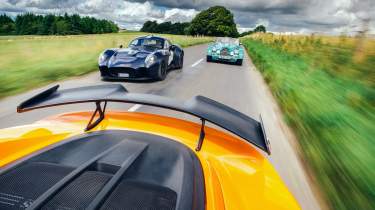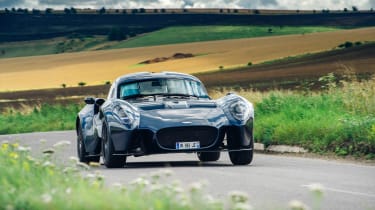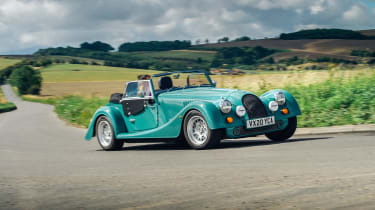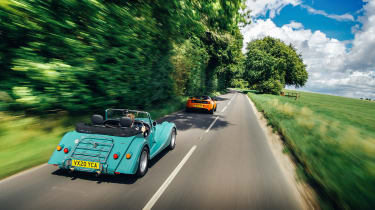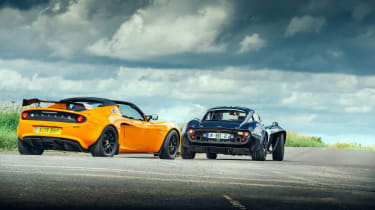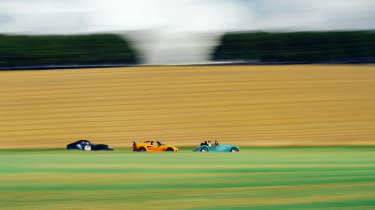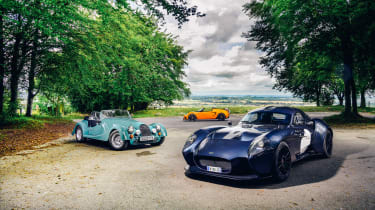Lightweight sports car test – Morgan vs Lotus vs Jannarelly
We pitch three lightweight sports cars against one another to see which is best
If you never even got a chance to drive Jannarelly’s new Design-1 sports car, you could derive plenty of entertainment from watching others get used to the quirks of entry, operation and exit, and a further layer of enjoyment from their reactions immediately after a drive.
Watching Adam Towler hoist himself out of the slim cockpit with a wide-eyed expression and puffed-out cheeks, I’m guessing he’s had quite an experience. Having spent probably a dozen hours in the car myself by this point it’s a familiar sensation. You emerge from every drive slightly frazzled, but also energised, in much the same way as you would from one of the more potent Caterham Sevens.
Given the company’s founder, Anthony Jannarelly, owns a Seven himself, the similarity of experience isn’t a huge surprise. The Design-1’s mission statement is effectively that of a more exotic, more touring-capable Seven – something with a proper roof, longer-distance legs and sleeker styling, but otherwise offering similarly involving and exciting driving manners.
This ‘Caterham, but more’ vibe is exactly why you won’t find an actual Caterham in this test. Consider the Jannarelly, just this once, a stand-in for the much-loved Brit; a different spin on a familiar experience. But it’s also why we’ve chosen to bring along a Lotus Elise, specifically a Tango-hued Cup 250. The Elise has been doing ‘Caterham, but more’ since 1996, and few, if any, have done the same job better in almost a quarter of a century.
And the Morgan Plus Four? It’s here because it’s new, and more importantly, it’s fun. That’s why we buy sports cars, after all. But Morgan is also the most visible proponent of the kind of small volume, handcrafted, bespoke service that Jannarelly now offers. You don’t buy a Morgan like you would its BMW Z4 engine donor, keeping up with a few PCP payments and then robotically trading it for something else a few years down the line. It’s a personal thing. You invest yourself in the build and the ownership, something Jannarelly will need to tap into if its appeal is to endure in the same way.
The Morgan seems the ideal choice to ease my way into the day. In theory, anyway. Few cars expose you to the elements like a Morgan, with its low screen and cutaway doors, but at least the company has addressed our criticisms of the Plus Six’s seating, the Four arriving with a pew you’d be happy to spend time in.
The £62,995 Plus Four looks fantastic, too. It’s so gloriously English you could drift one through the flower beds at Windsor with the Sex Pistols blaring from the stereo, and Her Maj’ would still smile and wave and ask you to ‘kerry orn’. Our test Mog’s off-green paintwork and 15-inch Campagnolo-style alloy wheels fit the look perfectly, and the Cibie covers on the slightly wobbly spotlights set things off a treat. There’s a tactile quality to everything you interact with too, whether it’s the heavily spring-loaded catches for the two-part bonnet release, or the satisfying clack of the doors, which feel not unlike latching the gate outside an old cottage.
Then you start it and the emerging sound is nothing like the snorty carb-fed grunt you’re expecting. Instead there’s a chunter and a whoosh and the distinctive rumble of exhaust gases breathing through a turbocharger. The BMW B48 2-litre, four-cylinder’s 255bhp is brawny though, and tied to a 1013kg dry kerb weight, it’ll paint vulcanised elevens at will in first gear and charges hard in every subsequent ratio after that. The six-speed manual gearbox is disappointingly obstructive, but each enforced punctuation provides brief respite before you enjoy the next bout of whooshing turbo noises.
Arriving at our second photography location of the day, I feel ready to reacquaint myself with the Lotus. Curiously, it’s the oldest car here but looks the newest by decades. And if the Morgan’s the kind of car to raise a smile from our head of state, the Cup 250’s Outspan hue, greyscale union-flagged rear wing and square-edged tyres are more like the Duke of Sussex flipping the bird before he disappears off to the colonies.
The weather’s dry, which means the roof is off, and this immediately takes ten points of difficulty off the process of installing yourself in the minimal cockpit. You sit high in the seat but low relative to everyone besides Olympic skeleton bob pilots, and it affords you a fantastic view through the deep windscreen and over the raised front wings. Taller folks might struggle with the non-adjustable steering wheel, forever an Elise demerit, but the seats are pretty good these days and the pedals and beautiful exposed-linkage gearshift are as perfectly sited as ever.
Where the Morgan whooshes and grumbles, the Elise barks. Twisting a nasty plastic key and prodding an even nastier plastic button take some of the magic away, but once the 245bhp 1.8-litre Toyota four-cylinder springs to life the exhaust emits a satisfying growl. It responds almost like an electric motor too, no doubt aided by Lotus’s decision to supercharge rather than turbocharge the 2ZR‑FE unit. Throttle, clutch and gearshift are in perfect balance with one another, making each and every movement of each and every control a pleasure, whether you’re ambling around or slicing through a change nanoseconds before the limiter cuts in. Earlier Elises may have had slightly disappointing gearshift actions, but the latest examples have one of the best manual changes anywhere – light, precise, and issuing an audible and tactile clack to corroborate each arm movement.
After the Morgan the rush of acceleration isn’t quite as intense, despite a power-to-weight ratio in the orange car’s favour, but you’ll hold on to each gear longer in the Lotus to enjoy the old-school rasp. It’s not like the Cup 250 is slow, either; Lotus quotes a 0-60mph time of under four seconds, making it quicker off the mark than an Alpine A110S or Porsche Cayman GTS, and with so little inertia behind it the Elise needs little effort to get moving. And it doesn’t struggle to stop; it’s good to know the light weight would be as beneficial lap after lap on track for brake and tyre life as it is for the car’s outright performance.
Past experience of the £85,969 Design-1 suggests it has several Elise-like qualities. It has a mid-mounted engine, minimal mass and unassisted controls on its side, and the steering rack is even an Elise part itself. The pared-back interior, while styled very differently to the Lotus’s, clearly exudes the same ethos too.
There the two branch apart. There’s a lot to take in with the Jannarelly, the first order of business being that engine location, because you’d swear at a glance it was front-mounted. The windscreen only starts halfway down the car’s length, in contrast to the Elise where it’s nearly over the front wheels (recently upsized to 17 inches to enable the fitment of Michelin Pilot Sport 4 tyres), but look more closely and you’ll realise the Design-1’s front end is fairly skeletal, with deep cooling slats in the bonnet, and the bodywork behind the front wheels is tucked in almost like that of a Grand Prix car. The large intakes on the rear haunches are a giveaway too, feeding air to the naturally aspirated Nissan V6.
In this left-hand-drive car you’re abundantly, and occasionally painfully, aware of the engine’s location, because a large cone air filter sits probably six inches from your left ear, and from the moment you fire up the six with a bomb switch on the dash to the moment you extinguish it again, you’re no more than a half-inch of throttle away from a rush of air being ingested. But don’t misinterpret this as criticism: between the filter and the pair of exhausts poking through the rear grille, the Design-1 sounds absolutely spectacular.
Hard acceleration is a white-knuckle ride. With 321bhp on offer it’s got more punch than either rival here, and being naturally aspirated it delivers its best at full throttle, towards the upper end of the 8000rpm-denoted rev counter. So you hang on, in more than one sense of the word, and savour the exotic 1960s sports car howl as it closes in on the limiter, intake huffing away and wind noise whipping against the tiny screen. During our test one observer will note that it sounds not unlike a V12 rather than a V6. Listening to Towler gun it up the road there’s definitely some truth to this, and it gives the Design-1 a personality quite unlike that of any other sports car on sale.
It’s physical, though. The gearchange, with its open linkage like in the Elise, takes muscle to notch around the gate, and a degree of concentration to avoid wrong-slotting, particularly as the weighty change and rampant performance means you’re inclined to thump each shift home rather than slowly guiding it. On bumpy roads the car also moves around a lot (the ride feels less settled on the new, larger wheels, though it’s far from uncomfortable), so at least some of your attention at full throttle needs to be devoted to staying in your lane as well as negotiating the gearbox.
Thanks to their compact dimensions any corner is a good place to explore the dynamics of these cars. The Jannarelly remains a workout, and again starts to show similarities with Caterhams. Braking effort is higher than average with no power assistance, but the feedback and power are both excellent. Crisp turn-in allows you to pick your line accurately, but the steering immediately weights up – disconcerting if you’re not expecting it – yet is detailed and receptive to changes in the surface. There’s huge front-end grip, so everything after that point is about getting back on the power, and with a large engine sitting almost over the rear axle and a progressive power delivery, the Design-1 sits down, 911-style, and launches out the other side, ready to scare you anew on the very next straight.
The Morgan is a workout too, but for slightly different reasons. After the Jannarelly it feels almost loose and baggy, with lighter brakes and steering and softer throttle response, and while the Design-1 shuffles with the contours of the road, the Plus Four skitters and bounces because its suspension feels just slightly unsophisticated. Tune into it, though, and things improve. It’s still responsive in its own way, the steering happily nudging the nose in whichever direction you’ve chosen, and the combination of a lighter engine up front, less power to the rear wheels and a more predictable manual shift make it feel less unhinged than its Plus Six sibling. You still feel a little exposed, skimming along the road on your perch, but back off a little and the Plus Four is genuinely good fun, making up in sensation of speed what it lacks in control or feedback.
Feedback is the Elise’s speciality, of course. It makes light work of any corner, from the way you can perfectly blip down the gearbox on the way in, to the stream of information at your fingertips before you even introduce any lock, to the completely instinctive way you can pour it through the turn with precision and economy of movement.
On the Cup 250’s sticky Yokohama Advan A052 tyres there’s actually relatively little adjustability, at least at road-going speeds, but it hardly matters because driving quickly in the Elise still feels like the complete sports car experience. Huge, unbreachable levels of grip are only a problem if they compel you to drive ever faster to desperately try to unearth some kind of interactivity, but since the Lotus delivers the bare essentials as soon as you get underway, it’s enjoyable whatever your commitment or talent level.
Both the other cars here do that too in their own way, the Morgan through its slightly old-school charm and the Jannarelly for its sensory bombardment. I can understand why someone would choose either – in part because their exclusivity and scope for personalisation goes far further than anything Lotus offers on the Elise, but also because each is a unique and thrilling experience in its own right. However, on driving experience alone, and that elusive ‘Caterham, but more’ combination of involvement and useability, the Elise remains our favourite.
This triple-test was first featured in issue 279 of evo magazine. To purchase the latest issue or subscribe, click here to visit our online shop
Click on the links below for our dedicated reviews of the cars featured in this test:
Specs
| Lotus Elise Cup 250 | Morgan Plus Four | Jannarelly Design-1 | |
| Engine | In-line 4-cyl, 1798cc, supercharged | In-line 4-cyl, 1998cc, turbocharged | V6, 3498cc |
| Power | 245bhp @ 7200rpm | 255bhp @ 5500rpm | 321bhp @ n/a rpm |
| Torque | 184lb ft @ 3500-5500rpm | 258lb ft @ 1000-5000rpm | 274lb ft @ n/a rpm |
| Weight | 931kg | 1013kg (dry) | 950kg |
| Power-to-weight | 267bhp/ton | 256bhp/ton (dry | 343bhp/ton |
| 0-62mph | 3.9sec | 5.2sec | 3.9sec |
| Top speed | 154mph | 149mph | 135mph (limited) |
| Basic price | £49,595 | £62,995 | £85,969 |
| evo rating | 5 | 4 | 4.5 |

